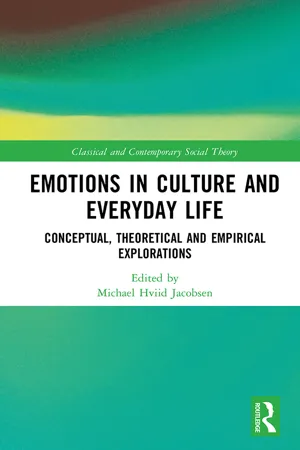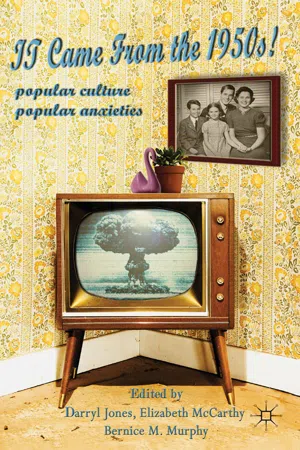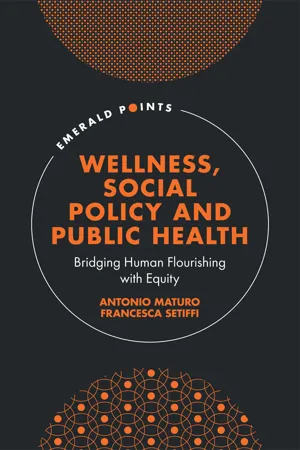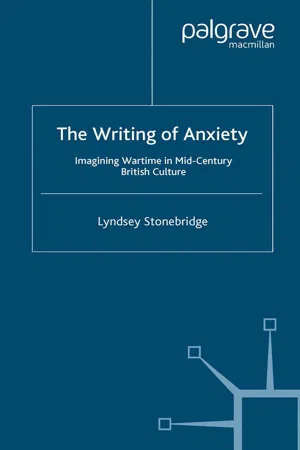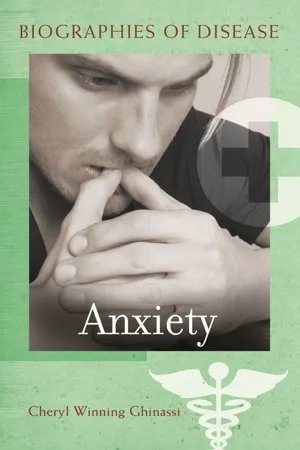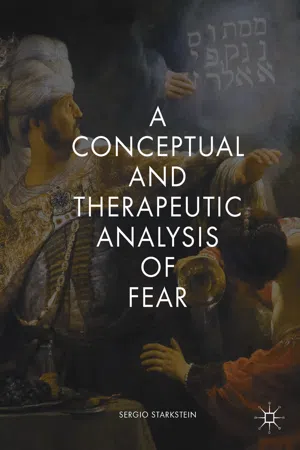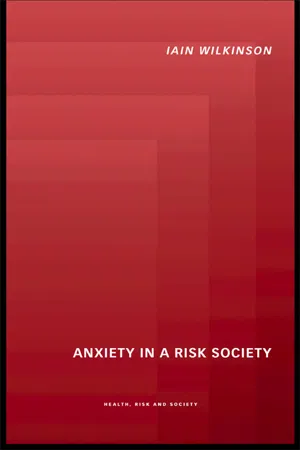History
Age of Anxiety
The "Age of Anxiety" refers to a period in the 20th century, particularly after World War I, characterized by widespread unease, disillusionment, and uncertainty. This term is often used to describe the social, cultural, and psychological impact of rapid industrialization, urbanization, and technological advancements, as well as the aftermath of global conflicts. It reflects a pervasive sense of insecurity and existential angst among individuals and societies.
Written by Perlego with AI-assistance
Related key terms
1 of 5
9 Key excerpts on "Age of Anxiety"
- eBook - ePub
Emotions in Culture and Everyday Life
Conceptual, Theoretical and Empirical Explorations
- Michael Hviid Jacobsen(Author)
- 2022(Publication Date)
- Routledge(Publisher)
8 AnxietyFear and worry in the modern mind
Jason S. SchnittkerDOI: 10.4324/9781003208556-9Introduction
Anxiety is common and highly active in the minds of those who experience it. Anxiety also has an unusually prominent cultural profile. At various times, authors have staked a claim on the present era being the true ‘Age of Anxiety’, more anxious than the eras preceding it, either because of new circumstances, abrupt calamities or lingering trauma. W. H. Auden perhaps staked the most visible claim on the idea with his mid-century poem The Age of Anxiety (1948), which focused on the dislocations associated with industrialisation. But anxiety has even broader cultural and scholarly resonance. It is featured prominently, for instance, in some accounts of social movements. Iain Wilkinson (2001) has argued that 20th century anxiety reflects the rising awareness and cataloguing of risk.Yet the significance of anxiety relative to other emotions has long been unclear, and as a form of psychological dysfunction – that is, as a kind of psychiatric problem – anxiety has often been overshadowed by other disorders. As a category, anxiety disorders are more prevalent than mood disorders, though historically mood disorders have been more prominent in medical treatment. In addition, evolutionary arguments position anxiety, fear and worry in terms of the fitness advantages they confer, leading some to downgrade anxiety as natural, useful and perhaps irrelevant as a facet of suffering. Anxiety need not be undesirable, and it may contribute to the high functioning of individuals and societies. The public, too, often dismisses anxiety as a matter of character and growth, something to overcome or even welcome, especially in the process of learning. But there is no doubt that anxiety can be excessive, unreasonable and counterproductive. Anxiety is often accompanied by alarming physical symptoms, too, including an elevated heart rate and rapid breathing. - eBook - ePub
Late Modern Subjectivity and its Discontents
Anxiety, Depression and Alzheimer’s Disease
- Kieran Keohane, Anders Petersen, Bert van den Bergh(Authors)
- 2017(Publication Date)
- Routledge(Publisher)
In 1947 (first in New York – then in 1948 in London) W.H. Auden famously proclaimed that time to be ‘the Age of Anxiety’ (Auden 1948). In his lengthy poem Auden, in the form of a dramatic allegory, identifies – and manifests – the basic human problem as man’s anxiety in time. Written in the aftermath of World War II, one understands why Auden’s poem is permeated with pessimism – especially concerning the psychic condition of his contemporaries. As Edward Callan writes:The plot of The Age of Anxiety reveals, not character development in the conventional sense, but development within the psychic personality. More specifically, the six parts of The Age of Anxiety are six stages in a regenerative journey; and, furthermore, each of the four central acts of the drama presents a search for ‘Wholeness’.Callan 1965: 157The Age of Anxiety, in Callan’s interpretation, thus voices a growing psychic fragmentation. There is a lack of wholeness at stake that is creating immense individual difficulties. People are torn apart and in desperate need of completeness. But alas – their search seems to be in vain. Now, the question arises whether Auden’s description of the Age of Anxiety is adequate when it comes to the Age of Anxiety that we are witnessing now. I think not. By answering in the negative, I am not questioning whether we in fact live in an Age of Anxiety. Because I – alongside many others (for example, Wilkinson 2001; Parish 2001; Salecl 2004; Horwitz 2013) – think that we do. I simply believe that we need another vocabulary to capture the specificities of this age rather than the one provided by Auden. In other words: I want to avoid the risk of portraying anxiety as a historical constant, however comforting that might be. Hence, in this chapter I will present the outline of an analysis that tries to answer one main question: why is anxiety indicative of our time?In order to answer this question in an acceptable manner I will proceed in four stages. First, I will substantiate the main claim of the article and explicate how one can legitimately call our age the Age of Anxiety. Second, I will elucidate specific kind(s) of anxiety that are sweeping through contemporary western societies and discuss why these kinds are particularly actualized. Third, I will explain why these kinds of anxiety (the kinds that seem to be very prevalent among youth and adolescence) are to be understood as signs of social pathology and not just individualized disorders. Fourth, I will conclude by discussing the main points of the chapter and by elaborating on future research possibilities that the chapter enables. - eBook - PDF
It Came From the 1950s!
Popular Culture, Popular Anxieties
- Darryl Jones, Elizabeth McCarthy, Bernice M. Murphy(Authors)
- 2011(Publication Date)
- Palgrave Macmillan(Publisher)
Introduction The Age of Anxiety. This was the title of W.H. Auden’s Pulitzer Prizewinning long poem of 1947, in which four representative charac- ters gather to talk, love and dream in a New York bar during World War II. Auden clearly caught a post-war mood, and the phrase ‘Age of Anxiety’ soon became proverbial, seeping into all levels of American culture over the next few years. The young composer Leonard Bernstein read The Age of Anxiety in the summer of 1947, and felt an ‘extreme personal identifi- cation of myself with the poem’, which signified for him ‘the record of our difficult and problematic search for faith’ in the modern world. His second symphony, composed in 1948–9, is his own record of his engage- ment with the poem’s themes and ideas; he called this symphony The Age of Anxiety. 1 Subtitled ‘A Baroque Eclogue’, and written in an alliterative verse-form which he adapted from Anglo-Saxon poetry, Auden’s poem would gener- ally be recognized as a characteristic high-cultural document, deploying a classic Modernist repertoire of allusions, images and registers to create a fragmented textual representation of the archetypal city of moder- nity, New York, the city to which Auden had moved in 1939. To a certain extent, The Age of Anxiety operates as a poetic response to T.S. Eliot’s The Waste Land (1922), the greatest of all poetic documents of the modern city (though its use of dream and stream-of-consciousness interior monologue also demonstrate the extent of Auden’s engagement with the later work of Joyce). What Auden’s poem does is to inscribe in poetic form the superseding of London by New York as the global mega- lopolis, itself a symbol of the rapid decline of the British Empire across the interwar years, and its replacement by the US as a global–imperial superpower. It might not have been a surprise to find Leonard Bernstein, sophisti- cated New York intellectual that he was, wrestling with the implications 1 - eBook - ePub
Wellness, Social Policy and Public Health
Bridging Human Flourishing with Equity
- Antonio Maturo, Francesca Setiffi(Authors)
- 2022(Publication Date)
- Emerald Publishing Limited(Publisher)
1
THE Age of Anxiety: BETWEEN ACCELERATION, PERFORMANCE, AND MEDICALIZATION
In this chapter, a description of some sociological theories that have identified some distinctive features of contemporary society presents an original reading analysis of them. Specifically, Hartmut Rosa's theory of acceleration; the systematization proposed by Federico Chicchi and Anna Simone regarding the sociological theories of the performance society; the description of the therapeutic culture provided by Frank Furedi; and Byung-Chul Han's arguments with respect to the social disappearance of pain in contemporary society. These perspectives are necessary to frame and hint at the possible role of wellness in a post-COVID society, a goal we develop in the Conclusion of this volume.THE Age of Anxiety
There is little doubt that our age is characterized by anxiety. Anxiety, stress, and discomfort are discussed and written about constantly in our society, in varying perspectives – from the broad and generic to the specialized and medical. Anxiety is discussed in connection to work, love, illness, travel, and (certainly in Italy) in relation to one's favorite soccer team. Veined with anxiety are the decisions concerning schools to choose for the child or hospitals to choose for the parents. Every opportunity is suitable to detect anxiety symptoms in our state of mind; as we will see in the following pages, even meditation can cause anxiety. Not to mention social media and TV programs that are prodigious manufacturers of negative and “anxiety-inducing” news. Nevertheless, why have we ended up in an “Age of Anxiety”?Historically, the explanation advanced by sociology focuses on the gradual collapse of ancient points of reference: values, institutional, and therefore cognitive. Of course, the consequences are also emotional because cognitive certainties produce positive feelings of stability and a sense of mastery of events: “Tradition has the hold it does […] because its moral character offers a measure of ontological security to those who adhere to it. Its psychic underpinnings are effective. There are ordinarily deep emotional investments in tradition, although these are indirect rather than direct; they come from the mechanisms of anxiety-control that traditional modes of actions and belief provide” (Giddens, 1994, pp. 65–66). - eBook - PDF
The Writing of Anxiety
Imagining Wartime in Mid-Century British Culture
- L. Stonebridge(Author)
- 2007(Publication Date)
- Palgrave Macmillan(Publisher)
Anxiety, then, tells us secret stories about ourselves. Add this to the distinctive temporality that Freud gives to anxiety – it looks both forwards and backwards; it is, as Theodor Reik argued, ‘Janus faced’ – and it perhaps becomes possible to begin to argue that anxiety for Freud, as for the 1940s novel, offers something like what we could call an affective historiography of trauma. 8 If wartime Britain was an anxious culture, it was because this kind of affective history was being told on so many different levels. Gripped by the anticipation of a trauma to come, haunted by the traumas of World War I and witness to the mass civilian bombing of the Spanish Civil War (as I discuss in the next chapter), the British population certainly had enough to be anxious about. But, as Freud points out, we are not actually anxious about the things we know (the wars of the twentieth century, even by the 1940s, were all too familiar); because anxiety has a distinctive ‘quality of indefiniteness and lack of an object’ it also tells the affective history of a life that is not consciously known – the life of the unconscious and of fantasy, what we can perhaps describe as Anxiety t at a Time of Crisis 19 the traumatic childhood of the real dangers of the present moment. 9 ‘If you think about it’, said Edward Glover, sending out his own (anxious) signals across the BBC airwaves at the beginning of the war: the whole atmosphere of modern war is likely to revive those unreas- oning fears that the human race has inherited from its remotest ancestors: gas masks that make us look like strange animals; under- ground shelters; rumours and suspicions; enemies overhead and unseen; wailing sirens; screaming air bombs, and vast explosions in the night. Small wonder, then, that we are afraid lest in the face of a real danger our first impulse should be to behave like little children [] We are afraid of being afraid. - 2 Anxiety through the Ages: Prehistory to the 1800s PREHISTORIC AND ANCIENT CIVILIZATIONS Since we now know that fear and anxiety involve brain biology, genetics, and evolution, we can conclude that these emotions have existed as long as there have been people. Very early evidence and historic writings, however, make little distinction between anxiety disorders and more severe mental ill- ness. Consequently, the early history of anxiety disorders is very much part of the early history of all mental illness, as well as the beginning of psychology and psychiatry. Spiritual Theories From Paleolithic times, humans have attempted treatments for those suffering from mental anguish and odd behaviors. A procedure called trephining was prac- ticed, which entailed the boring of a hole in the back of the skull to relieve pres- sure on the head. This drastic procedure would undoubtedly have killed more victims than it cured. Archeologists have also uncovered evidence that those suf- fering from mental disorders wore amulets to help drive away evil spirits. Early ideas about mental illness fell into the realm of the mystical. Primi- tive humans embraced spiritual theories to explain many of life’s phenomena and to calm the anxieties of their difficult lives. An attempt to explain strange behavior is later seen in the writings of the ancient Babylonians, who flour- ished from 2000 to 500 BCE. The Babylonians, like the Persians, Egyptians, and Hindus, concluded that mental and physical maladies were a result of powerful gods who had been angered by the disobedient individual. The earliest references to fear and anxiety come to us from ancient Egypt, Rome, and Greece. The Greek god Pan, the instigator of fear and anxiety, was an irritable and unpredictable satyr whose bellowing would terrify humans. His name is the root of the word panic. Priests, wizards, shamans, medicine men, and magicians were the early healers of mental and physical illness.
- eBook - ePub
- Sergio Starkstein(Author)
- 2018(Publication Date)
- Palgrave Macmillan(Publisher)
20 Far from Kierkegaard’s understanding of the anxiety of being human (inner dread), though as part of a sociological movement that frequently references it, these authors conceptualise anxiety as being determined by powerful socioeconomic factors acting on the individual, an understanding commonly referred to under the more generic term, the ‘social construction of emotions’.Boiger and Mesquita define the “social construction of emotions” as the understanding that emotions are primarily constituted, shaped and defined by social contexts (Boiger and Mesquita 2012 ). They also suggest that the social construction of emotions depends on three primary situations. The first, termed “moment-to-moment interactions”, refers to the fact that emotions are constructed at the time of social exchange, for instance, when I develop anxiety after a friend tells me about future job cuts in my work place. Accordingly, anxiety is shaped by present social exchanges and their future implications for the individual. The second kind of situation occurs when social interactions directly produce anxiety, and the emotion impacts, in a circular way, upon the social interaction. For instance, this occurs when my boss’s actions and words make me feel continuously anxious, and my anxiety further shapes interactions with my boss. The third situation relates to specific socio-cultural contexts. Based on this perspective, social norms are the framework on which emotions are constructed and interpreted, and the defining characteristics of mental illness depend on cultural rules concerning what is normal or abnormal (Averill 2012 ). For instance, anxiety may be more frequent in developing countries, where the job situation is more precarious than in developed countries. In conclusion, the social construction of emotions is considered as a dynamic process of social interaction in given socio-cultural contexts. Within this framework, the increasing use of anti-anxiety medications such as Valium is symptomatic of social construction and medicalization given that in the opinion of some sociologists this treatment only provides a temporary emotional relief without addressing the social forces that cause anxiety, such as work, family and social isolation (Koumjian 1981 - eBook - ePub
- Iain Wilkinson(Author)
- 2002(Publication Date)
- Routledge(Publisher)
only when we are prepared to consider the subjective meanings which people acquire and create for events in their lives that we may begin to piece together a more complete explanation for the prevalence of psychological distress among different sectors of the population. In the final section I argue that while it is possible to identify the types of social events and processes which make people vulnerable to anxiety, when we become alert to the moderating force of meaning upon our psychology we might also be in a position to recognise that their experience of anxiety is determined by cultural processes which are always open to change. Accordingly, I refer to the current transformation of British family life and new developments in the search for intimacy as examples of social contexts where it appears that researchers may have to substantially revise their understandings of the types of relationships which are most conducive to our mental health.To know another’s feelings
There are many different forms of culture through which we may express the content of our feelings, but it is only in the last century that large numbers of people have come to explicitly refer to a portion of their emotional and psychological distress in terms of the ‘problem of anxiety’ (May 1977: 3–19). ‘Anxiety’ may well be just a modern name for an age-old feeling which is an inevitable consequence of the psychic constitution of our humanity. Accordingly, in a secular culture one might recognise the language of psychology to have replaced that of religion as the preferred means of interpreting the felt quality of our inner experience of life; when it comes to discussing matters of feeling, we now prefer to speak with deference to the authority of experts in the fields of human science rather than the (more doubtful) wisdom of those who would explain our problems in terms of our relationship towards God. However, in taking up the languAge of Anxiety, perhaps we have not only come to explain ourselves differently, but further, we may also have begun to modify the way we feel.Raymond Williams (1961: 63–6) suggests that each culture has its own peculiar structure of feeling. Language is but a small part of the many elements which comprise a whole way of life which, retrospectively, we may identify as belonging to a distinctive period of our cultural history. Where it is possible for us to document a change in the use of language, this may not only mark a shift of attitudes and behaviour, but also, in the ‘felt sense of the quality of life’ for those living in a particular time and place. Moreover, Williams contends that even where we find successive generations who speak ‘the same language’, we should still expect each to possess its own distinctive sense of style and expression whereby they are likely to feel somewhat differently about their lives. He argues: - eBook - ePub
- Dr John Haffenden, John Haffenden(Authors)
- 2002(Publication Date)
- Routledge(Publisher)
’The Age of Anxiety’
New York, July 1947; London, September 1948
Passage contains an image
99 M.L. ROSENTHAL, SPEAKING GREATLY IN AN AGE OF CONFUSION, ‘NEW YORK HERALD TRIBUNE’
20 July 1947, section 7, 3
M.L. Rosenthal (b. 1917), poet and critic, has taught at New York University since 1945. His publications include ‘The Modern Poets’ (1960), ‘The New Poets: American and British Poetry since World War II’ (1967), and ‘Sailing into the Unknown: Yeats, Pound, and Eliot’ (1978).This is the first poem, in English at any rate, that speaks boldly, greatly and at length of our sick, desperate confusion in this era of the second world war. It will give sharp reminder to our numerous talented minor poets that there can be strength and responsibility in their art:All that exists Matters to man; he minds what happens And feels he is at fault, a fallen soul With power to place, to explain every What in his world but why he is neither God nor good….The vigor, even the quality, of the ideas in ‘The Age of Anxiety’ must obviously be tested by their influence on its readers, many of whom will doubtless find Auden’s diagnosis, with all its pessimism, infinitely superior to his suggested cure. But no one who takes up this emotionally stunning work is likely to concern himself immediately with whether or not he agrees with the author. Rather, his attention will be absorbed by the various centers of concentration along which the ‘plot’ is strung, each of them one aspect of a continuous, straining effort to get at the heart of the human condition and trace the lines of possible (or impossible) salvation. He will be carried along, too, by the muscular alliterative sweep of the lines, subtly and marvelously varied from the simple basic pattern to fit a number of modes, from sweet lyric to intellectualized argument, from sharp satire to poignant introspection.
Index pages curate the most relevant extracts from our library of academic textbooks. They’ve been created using an in-house natural language model (NLM), each adding context and meaning to key research topics.
